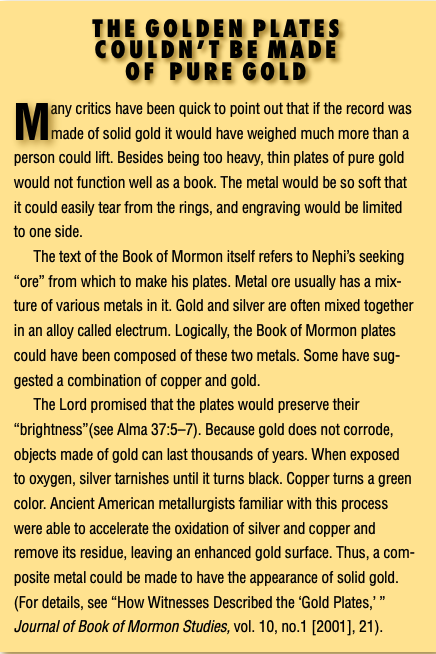Church magazine addresses weight of the plates.
- Type
- Periodical
- Source
- The Church of Jesus Christ of Latter-day Saints LDS
- Hearsay
- Secondary
- Reference
"The Golden Plates Couldn't Be Made of Pure Gold," New Era, July 2007, 30.
- Scribe/Publisher
- The Church of Jesus Christ of Latter-day Saints
- People
- The Church of Jesus Christ of Latter-day Saints
- Audience
- Reading Public
- Transcription
Many critics have been quick to point out that if the record was made of solid gold it would have weighed much more than a person could lift. Besides being too heavy, thin plates of pure gold would not function well as a book. The metal would be so soft that it could easily tear from the rings, and engraving would be limited to one side.
The text of the Book of Mormon itself refers to Nephi’s seeking “ore” from which to make his plates. Metal ore usually has a mixture of various metals in it. Gold and silver are often mixed together in an alloy called electrum. Logically, the Book of Mormon plates could have been composed of these two metals. Some have suggested a combination of copper and gold.
The Lord promised that the plates would preserve their “brightness”(see Alma 37:5–7). Because gold does not corrode, objects made of gold can last thousands of years. When exposed to oxygen, silver tarnishes until it turns black. Copper turns a green color. Ancient American metallurgists familiar with this process were able to accelerate the oxidation of silver and copper and remove its residue, leaving an enhanced gold surface. Thus, a composite metal could be made to have the appearance of solid gold. (For details, see “How Witnesses Described the ‘Gold Plates,’” Journal of Book of Mormon Studies, vol. 10, no.1 [2001], 21).
- Citations in Mormonr Qnas
The B. H. Roberts Foundation is not owned by, operated by, or affiliated with the Church of Jesus Christ of Latter-day Saints.

